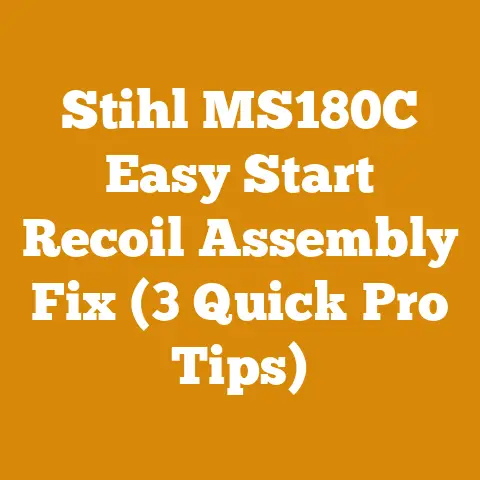DIY Tiller Build for Woodlands (Innovative Backyard Soil Prep)
Imagine turning your backyard into a thriving garden oasis without breaking the bank. With a DIY tiller, you can prep your woodland soil effectively, save money, and enjoy the satisfaction of building something yourself. This guide will show you how.
DIY Tiller Build for Woodlands: Innovative Backyard Soil Prep
Globally, the wood processing and firewood industry is experiencing a fascinating shift. According to recent data from the FAO (Food and Agriculture Organization of the United Nations), the demand for sustainably sourced firewood is on the rise, driven by both environmental concerns and increasing energy costs. Simultaneously, the market for small-scale logging tools and DIY equipment is booming, fueled by hobbyists and small landowners looking to manage their properties efficiently. For example, did you know that North America alone consumes over 70 million cords of firewood annually? That’s a lot of wood, and many people are finding innovative ways to process it themselves.
The beauty of wood processing and firewood preparation lies in its hands-on nature. I’ve spent years in the woods, from felling trees with a trusty chainsaw to splitting logs under the crisp autumn air. I’ve learned that the right tools and techniques can make all the difference. This guide aims to equip you with that knowledge, so you can tackle your wood processing projects with confidence and efficiency.
Let’s dive into building your own tiller for woodland soil preparation.
Understanding the Project: Why DIY?
Building your own tiller isn’t just a fun project; it’s a practical solution for those with limited budgets or specific soil needs. Store-bought tillers can be expensive, and often aren’t designed for the unique challenges of woodland soil, which is often rocky, compacted, and filled with roots.
- Cost Savings: A DIY tiller can save you hundreds, if not thousands, of dollars.
- Customization: You can tailor the design to your specific soil type and garden size.
- Resourcefulness: Using recycled parts promotes sustainability and reduces waste.
- Skill Development: You’ll gain valuable mechanical and fabrication skills.
Key Concepts: Soil Prep and Tilling
Before we get our hands dirty, let’s define some key concepts.
- Tilling: The process of breaking up and aerating soil to prepare it for planting.
- Woodland Soil: Soil typically found in forested areas, characterized by high organic matter, acidity, and potential compaction.
- Soil Amendment: Materials added to the soil to improve its physical and chemical properties (e.g., compost, manure, lime).
- Green Manure: A crop grown specifically to be tilled back into the soil to improve fertility and structure.
Part 1: Planning and Design
The success of your DIY tiller hinges on careful planning and design. I can’t stress this enough. A well-thought-out design will save you time, money, and frustration in the long run.
1.1 Research and Inspiration
Start by researching existing tiller designs. Look online for DIY tiller projects, watch YouTube videos, and browse forums dedicated to gardening and small-scale farming. Pay attention to the different types of tillers (front-tine, rear-tine, rotary) and their suitability for woodland soil.
1.2 Defining Your Needs
Consider the following factors when designing your tiller:
- Garden Size: How large is your garden? A smaller garden might only require a compact, lightweight tiller.
- Soil Type: Is your soil sandy, loamy, or clay-rich? Woodland soil often contains rocks and roots, which require a more robust tiller.
- Power Source: Will your tiller be gas-powered, electric, or human-powered? Gas-powered tillers offer more power but require more maintenance. Electric tillers are quieter and cleaner but may have limited power. Human-powered tillers are ideal for small gardens and offer a good workout!
- Budget: How much are you willing to spend on materials? Prioritize essential components and look for affordable alternatives.
1.3 Choosing a Design
Based on your research and needs, select a design that suits your skills and resources. Here are a few popular options:
- Rotary Tiller Attachment for Lawn Mower: This design utilizes the engine of an existing lawn mower to power the tiller. It’s a cost-effective option if you already own a lawn mower.
- Electric Tiller Conversion: Convert an old electric motor into a tiller. This option is environmentally friendly and relatively quiet.
- Hand-Powered Broadfork Tiller: A simple, human-powered tiller that uses a series of tines to loosen the soil. It’s ideal for small gardens and requires no electricity or fuel.
1.4 Sketching and Diagramming
Create a detailed sketch of your tiller design, including dimensions and component placement. Use a CAD program or simply draw it by hand. A detailed diagram will help you visualize the project and identify potential problems before you start building.
Part 2: Gathering Materials and Tools
Once you have a design, it’s time to gather the necessary materials and tools. This is where resourcefulness comes in handy. Scour local scrapyards, flea markets, and online marketplaces for used parts.
2.1 Essential Materials
- Engine/Motor: A gas engine (e.g., from a lawn mower or generator) or an electric motor (e.g., from a washing machine or treadmill).
- Tines: Hardened steel tines to break up the soil. You can purchase pre-made tines or fabricate your own from steel bars.
- Frame: Steel tubing or angle iron to construct the tiller frame.
- Wheels: Wheels to move the tiller across the garden.
- Bearings: Bearings to support the rotating parts of the tiller.
- Chain/Belt: A chain or belt to transmit power from the engine/motor to the tines.
- Sprockets/Pulleys: Sprockets or pulleys to adjust the speed and torque of the tines.
- Fasteners: Bolts, nuts, screws, and washers to assemble the tiller.
2.2 Essential Tools
- Welder: For welding the frame components together.
- Angle Grinder: For cutting and grinding metal.
- Drill: For drilling holes for fasteners.
- Wrench Set: For tightening bolts and nuts.
- Socket Set: For tightening bolts and nuts.
- Measuring Tape: For accurate measurements.
- Level: For ensuring the tiller is level.
- Safety Glasses: To protect your eyes from flying debris.
- Gloves: To protect your hands from cuts and burns.
- Hearing Protection: To protect your ears from loud noises.
2.3 Sourcing Materials Affordably
- Scrapyards: Scrapyards are a goldmine for used metal and mechanical parts.
- Flea Markets: Flea markets often have vendors selling used engines, motors, and tools.
- Online Marketplaces: Websites like Craigslist and eBay offer a wide selection of used parts at competitive prices.
- Local Hardware Stores: Hardware stores are a reliable source for new materials and fasteners.
- Recycling Centers: Check with your local recycling center for discarded appliances and equipment that might contain useful parts.
Part 3: Building the Tiller Frame
The frame is the backbone of your tiller. It must be strong and durable enough to withstand the rigors of tilling.
3.1 Cutting the Metal
Using an angle grinder, cut the steel tubing or angle iron to the required lengths according to your design. Be precise with your measurements to ensure the frame is square and level.
3.2 Welding the Frame
Weld the frame components together using a welder. If you’re not comfortable welding, consider hiring a professional welder or taking a welding class. Ensure all welds are strong and free of defects.
- Safety First: Always wear safety glasses, gloves, and a welding helmet when welding.
- Proper Ventilation: Weld in a well-ventilated area to avoid inhaling harmful fumes.
- Practice Makes Perfect: Practice welding on scrap metal before welding the frame components.
3.3 Grinding and Finishing
Once the frame is welded, use an angle grinder to smooth out any rough edges or welds. Apply a coat of rust-resistant paint to protect the frame from corrosion.
Part 4: Installing the Tines
The tines are the heart of the tiller. They are responsible for breaking up the soil.
4.1 Attaching the Tine Shaft
Attach the tine shaft to the frame using bearings. The bearings will allow the tine shaft to rotate smoothly.
4.2 Mounting the Tines
Mount the tines to the tine shaft. Ensure the tines are securely fastened and evenly spaced.
- Tine Orientation: Pay attention to the orientation of the tines. They should be angled to effectively dig into the soil.
- Tine Spacing: Adjust the tine spacing to achieve the desired tilling width and depth.
4.3 Testing the Tines
Rotate the tine shaft by hand to ensure the tines are properly aligned and rotate freely.
Part 5: Power Transmission
The power transmission system transfers power from the engine/motor to the tines.
5.1 Mounting the Engine/Motor
Mount the engine/motor to the frame. Ensure the engine/motor is securely fastened and properly aligned with the tine shaft.
5.2 Installing the Chain/Belt
Install the chain or belt to connect the engine/motor to the tine shaft. Use sprockets or pulleys to adjust the speed and torque of the tines.
- Chain/Belt Tension: Adjust the chain/belt tension to prevent slippage and ensure efficient power transmission.
- Sprocket/Pulley Ratio: Experiment with different sprocket/pulley ratios to find the optimal speed and torque for your soil type.
5.3 Testing the Power Transmission
Start the engine/motor and observe the rotation of the tines. Ensure the power transmission system is working smoothly and efficiently.
Part 6: Adding Wheels and Handles
Wheels and handles make the tiller easier to maneuver and control.
6.1 Attaching the Wheels
Attach the wheels to the frame. Ensure the wheels are securely fastened and can rotate freely.
6.2 Installing the Handles
Install the handles to the frame. The handles should be ergonomically designed for comfortable operation.
- Handle Height: Adjust the handle height to suit your height and preferences.
- Handle Grips: Use comfortable handle grips to reduce fatigue during tilling.
6.3 Testing the Mobility
Push the tiller around to ensure it is easy to maneuver and control.
Part 7: Safety Features
Safety is paramount when operating any power equipment.
7.1 Adding a Kill Switch
Install a kill switch to quickly shut off the engine/motor in case of an emergency.
7.2 Installing Guards
Install guards to protect the operator from flying debris and rotating parts.
7.3 Safety Labels
Affix safety labels to the tiller to remind the operator of potential hazards.
Part 8: Testing and Tuning
Before you start tilling your garden, it’s important to test and tune your tiller.
8.1 Test Run
Start the tiller and run it in a safe area. Observe the operation of all components and make any necessary adjustments.
8.2 Tilling Test
Till a small area of your garden to test the tiller’s performance. Adjust the tilling depth and speed to achieve the desired results.
8.3 Fine-Tuning
Make any necessary adjustments to the engine/motor, tines, or power transmission system to optimize the tiller’s performance.
Part 9: Using Your DIY Tiller
Now that your DIY tiller is complete, it’s time to put it to work!
9.1 Preparing the Soil
Remove any rocks, roots, and debris from the area to be tilled.
9.2 Tilling Technique
Start tilling at one end of the garden and work your way to the other. Overlap each pass slightly to ensure complete coverage.
9.3 Soil Amendments
After tilling, add soil amendments such as compost, manure, or lime to improve the soil’s fertility and structure.
9.4 Planting
Once the soil is prepared, you can start planting your garden!
Part 10: Maintenance and Troubleshooting
Regular maintenance will keep your DIY tiller running smoothly for years to come.
10.1 Cleaning
Clean the tiller after each use to remove dirt, debris, and plant matter.
10.2 Lubrication
Lubricate all moving parts regularly to prevent wear and tear.
10.3 Inspections
Inspect the tiller regularly for loose bolts, worn parts, or other potential problems.
10.4 Troubleshooting
- Engine/Motor Won’t Start: Check the fuel level, spark plug, and ignition system.
- Tines Won’t Rotate: Check the chain/belt tension, sprockets/pulleys, and bearings.
- Tiller Vibrates Excessively: Check the tine alignment, engine/motor mounting, and frame integrity.
Case Study: My Own DIY Tiller Journey
I remember the first time I tried to till my woodland garden using a store-bought tiller. It was a disaster! The tiller kept getting stuck on rocks and roots, and the engine was constantly stalling. Frustrated, I decided to build my own tiller.
I started by scavenging parts from an old lawn mower and a discarded washing machine. I welded together a simple frame, attached some hardened steel tines, and rigged up a power transmission system using a chain and sprockets.
The result was a crude but effective tiller that could handle the challenges of my woodland soil. It wasn’t pretty, but it got the job done. Over the years, I’ve refined the design and added improvements such as a kill switch, guards, and ergonomic handles.
Building my own tiller was a challenging but rewarding experience. It saved me money, taught me valuable skills, and gave me a sense of accomplishment.
Costs and Budgeting
The cost of building a DIY tiller can vary depending on the materials you use and the complexity of the design. Here’s a rough estimate:
- Engine/Motor: $50-$200 (used) / $100-$500 (new)
- Tines: $20-$50
- Frame: $30-$100
- Wheels: $20-$50
- Bearings: $10-$30
- Chain/Belt: $10-$30
- Sprockets/Pulleys: $10-$30
- Fasteners: $10-$20
- Paint: $10-$20
Total Estimated Cost: $170-$930
To save money, look for used parts, recycle materials, and prioritize essential components.
Challenges Faced by Small Workshops and Independent Loggers
Small workshops and independent loggers often face unique challenges, including:
- Limited Access to Capital: Securing financing for equipment and materials can be difficult.
- Competition from Larger Companies: Competing with larger companies that have economies of scale can be challenging.
- Regulatory Compliance: Navigating complex regulations related to logging and wood processing can be time-consuming and expensive.
- Safety Concerns: Logging and wood processing are inherently dangerous activities, and safety must be a top priority.
Next Steps and Additional Resources
- Join a Gardening Club: Connect with other gardeners and share ideas and resources.
- Attend a Workshop: Learn new skills and techniques from experienced gardeners and woodworkers.
- Visit a Local Farm: See how professional farmers prepare their soil and manage their crops.
- Consult with a Soil Expert: Get personalized advice on soil testing, amendments, and planting.
Suppliers of Logging Tools and Drying Equipment:
- Bailey’s: Chainsaws, logging tools, and safety equipment.
- Northern Tool + Equipment: Engines, motors, and mechanical parts.
- Woodland Direct: Firewood processors and drying kilns.
Building a DIY tiller is a rewarding project that can save you money, improve your garden, and teach you valuable skills. With careful planning, resourcefulness, and a little elbow grease, you can create a custom tiller that meets your specific needs and helps you achieve your gardening goals. Remember, Rome wasn’t built in a day, and neither is the perfect garden. So, get out there, get your hands dirty, and enjoy the process!






